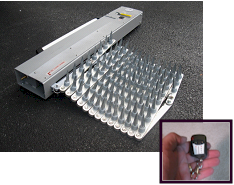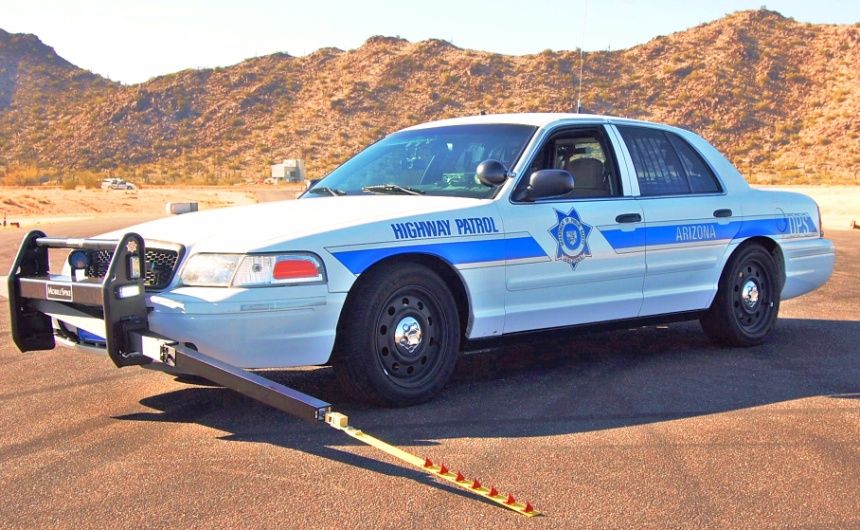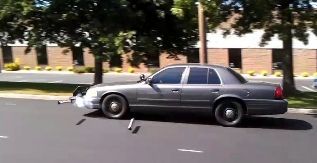For almost 25 years now, police departments across the country have been using tire deflation devices to help bring high speed pursuits to an end. The two most popular models currently in use are the Stinger® sold by Federal Signal and the Stop Stick® sold by Stop Tech Inc. While these tire deflation devices or “spike strips” have helped bring thousands of high speed chases to an end, there are inherent risks associated with their use. The Officer Down Memorial Page website, located at http://blog.odmp.org/ lists the names of 21 police officers that are known to have been killed while deploying a tire deflation device. Just recently, a North Carolina State Trooper was killed while deploying a tire deflation device to halt a driver wanted for a variety of felony charges including kidnapping, burglary and robbery.
Deploying tire deflation devices is a real danger for police officers. Offenders who are fleeing from pursuing officers have no concern for other motorists, let alone the officers chasing them or attempting to stop them. There have been many documented cases of offenders intentionally striking officers on the side of the road who were attempting to deploy spike strips. Additionally, several officers have been fatally struck by police vehicles during the chaotic moments of deploying and retracting the devices.
There are several weaknesses with the current tire deflation technology that places police officers in harm’s way. The biggest single weakness is the need for the officer to stand along the road and essentially throw the device into the path of the fleeing vehicle. This requires the police officer to stand along the road, adjacent to the very thing a fleeing vehicle is trying to avoid. In all too many cases, a fleeing vehicle attempts to drive around the tire deflation device and ends up hitting the police officer.
Another significant weakness is the need for a police officer to hold onto a rope so that the tire deflation device can be pulled from the road to prevent the spiking of the pursuit vehicles. Countless officers have been severely injured when the device gets caught up in the fleeing vehicle’s tires and the rope is violently pulled from the officer’s hand.
While proper training and practice can minimize the risks associated with the current tire deflation devices, injuries and deaths will continue to occur. There is however new technology just entering the market that addresses these weaknesses that police departments should consider.
NEW TECHNOLOGY ON THE HORIZON
Given the number of deaths and injuries associated with the current tire deflation devices, and the decision by many police departments to completely abandon their use due to safety and liability concerns, several companies have developed new technology that increases officer safety while improving the likelihood of bringing a pursuit to a safe end.
DYNASPIKE™ by DynaSystems LLC
 DynaSystems’ DynaSpike™ uses a unique approach to extend and retract the spike strip into the path of a fleeing vehicle by using a wireless remote control. A simple click of the wireless remote control is all it takes to extend the spikes across the road and into the path of the fleeing vehicle. The single, accordion-action links, similar to Federal Signal’s Stinger, extends over 17.5 feet in approximately 1 second. Officers can extend and retract the spikes from a safe location up to 100 yards away. The rapid extension and extra-width road coverage minimizes avoidance by fleeing suspects. After spiking the fleeing vehicle, another click on the wireless remote quickly retracts the unit in under a second, clearing the road for pursuit vehicles and other traffic. The DynaSpike system employs high strength, hollow spikes that penetrate all types of tires – including self-sealing and run-flats – and deflate them in a regulated manner. This prevents blowouts, slows the perpetrator’s vehicle to a safer rate of speed, and allows him to make a controlled stop.
DynaSystems’ DynaSpike™ uses a unique approach to extend and retract the spike strip into the path of a fleeing vehicle by using a wireless remote control. A simple click of the wireless remote control is all it takes to extend the spikes across the road and into the path of the fleeing vehicle. The single, accordion-action links, similar to Federal Signal’s Stinger, extends over 17.5 feet in approximately 1 second. Officers can extend and retract the spikes from a safe location up to 100 yards away. The rapid extension and extra-width road coverage minimizes avoidance by fleeing suspects. After spiking the fleeing vehicle, another click on the wireless remote quickly retracts the unit in under a second, clearing the road for pursuit vehicles and other traffic. The DynaSpike system employs high strength, hollow spikes that penetrate all types of tires – including self-sealing and run-flats – and deflate them in a regulated manner. This prevents blowouts, slows the perpetrator’s vehicle to a safer rate of speed, and allows him to make a controlled stop.
The DynaSpike is small enough to store in the trunk of a police cruiser and may be set up on the side of the road in under 20 seconds. The unit is designed to be used over and over again and the individual spikes are replaceable after each use. Simple pressurized air is used to power the extension and retraction of the DynaSpike and the pressurized air is re-charged after each use using a standard 12V air compressor that comes with each unit.
While the DynaSpike is heavier than the Stinger or Stop Stick, it has a comfortable handle that allows it to be easily carried and set up along the shoulder of the road. Another huge advantage of this new system is its ability to lie in wait and spring out of nowhere to strike a fleeing vehicle. Since the police officer doesn’t need to stand anywhere near the device, the element of surprise and the fast acting extension prevents the fleeing car from driving around the spikes. This will result in more cars getting spiked on the first attempt and have the pursuit come to a quick and safe end.
A complete DynaSpike system starts at $1,500 and quantity discounts are available. For more information you can contact DynaSystems LLC at their website at http://www.dynaspike.com/.
MOBILESPIKE™ by Pursuit Management
 Pursuit Management’s MobileSpike™ offers an alternative deployment method. The MobileSpike is mounted to the front bumper area of the cruiser and the system consists of a combination push bumper and mechanical arm. The arm can be set to deploy the spiking strip on the left or right side and weighs about 86 pounds.
Pursuit Management’s MobileSpike™ offers an alternative deployment method. The MobileSpike is mounted to the front bumper area of the cruiser and the system consists of a combination push bumper and mechanical arm. The arm can be set to deploy the spiking strip on the left or right side and weighs about 86 pounds.
When the decision is made to deploy the system the officer moves up alongside the suspect vehicle with the front bumper ahead of the rear tire. The officer maintains a distance of six feet from the fleeing vehicle.
The system is air operated by the driver of the squad car. The system can be armed and ready when the squad car is in position. A flip of the activation button extends the arm with a flexible spiking strip attached at the end. The officer applies the brakes and the spiking strip goes under the tires. The arm retracts automatically back into the push bumper mounting when the activation button is released. The deflation is controlled and takes about a minute. The total time of deployment for the MobileSpike system is under 10 seconds.
The spike strip is easily replaced by simply pulling a pin, removing the old spike strip and replacing it with a new strip.
The system has several advantages of the system over a normal deflation device. Because the device is on a moving vehicle an additional officer isn’t required to determine where the pursuit is going and set up the spikes on an intercepting path. This frees up that officer to join in the pursuit or take other appropriate actions.
Officer safety is enhanced since the officer has the added security of being protected by the safety devices contained in their squad car like seat belts and air bags, unlike the officer out on foot during a hand deployment of a deflation device.
The positioning of the squad car is familiar to officers trained in the Pursuit Intervention Technique (P.I.T.) making training easier for those officers. The complete MobileSpike system cost $5,000. For more information you can contact Pursuit Management Inc. through their website at http://www.mobilespike.com/.
PT1100 by End-X Systems
 Similar to the MobileSpike, End-X Systems’ PT1100 is mounted to the front bumper area of the cruiser but instead of using a mechanical arm, the PT1100 ejects three Stop Sticks® into the roadway from the safety of the driver’s seat. When the Stop Sticks® are deployed, they are configured to land at different distances from the vehicle thereby covering the full lane in one deployment.
Similar to the MobileSpike, End-X Systems’ PT1100 is mounted to the front bumper area of the cruiser but instead of using a mechanical arm, the PT1100 ejects three Stop Sticks® into the roadway from the safety of the driver’s seat. When the Stop Sticks® are deployed, they are configured to land at different distances from the vehicle thereby covering the full lane in one deployment.
The patent pending PT1100 can be deployed from several different positions. First, it can deploy from a stationary or stopped position as the fleeing vehicle passes by. The PT1100 can also be deployed from a moving position while traveling in the same direction as the pursued vehicle. In this instance, the officer would position the patrol vehicle slightly in front of the fleeing vehicle and slightly to the right of it for deployment. Another position that can be used is also from the moving position, but on-coming to the pursuit. The system can be used at speeds up to 60 MPH.
This flexibility allows the officers the ability to get Stop Sticks® down much earlier in the pursuit than ever before possible. The system also allows officers to remain inside their vehicles during the critical phases of deployment, which is the most dangerous time for an officer to be standing in the middle of the road. The array of options allows officers to engage in shorter pursuits, reducing liability for the city and the chance of injuries or fatalities.
For more information you can contact End-X Systems through their website at http://endxsystems.com.
CONCLUSION
When deployed correctly, traditional spike strip systems are effective in ending pursuits; however, the Stinger and Stop Stick systems come with significant risks to officer safety. Officers must risk life and limb to manually throw the spike strip in front of the fleeing vehicle and then rip it back out of the road so the pursuing vehicles can continue the chase. New ground-deployed systems such as the DynaSpike and vehicle-deployed systems such as the MobileSpike and PT1100 offer significant promise for decreasing officer injuries and in turn reducing police department insurance rates and disability pay-outs. With these new technologies on the market and more pressure on departments to increase officer safety while cutting costs, it begs the question of whether traditional spike strips are a way of the past.

